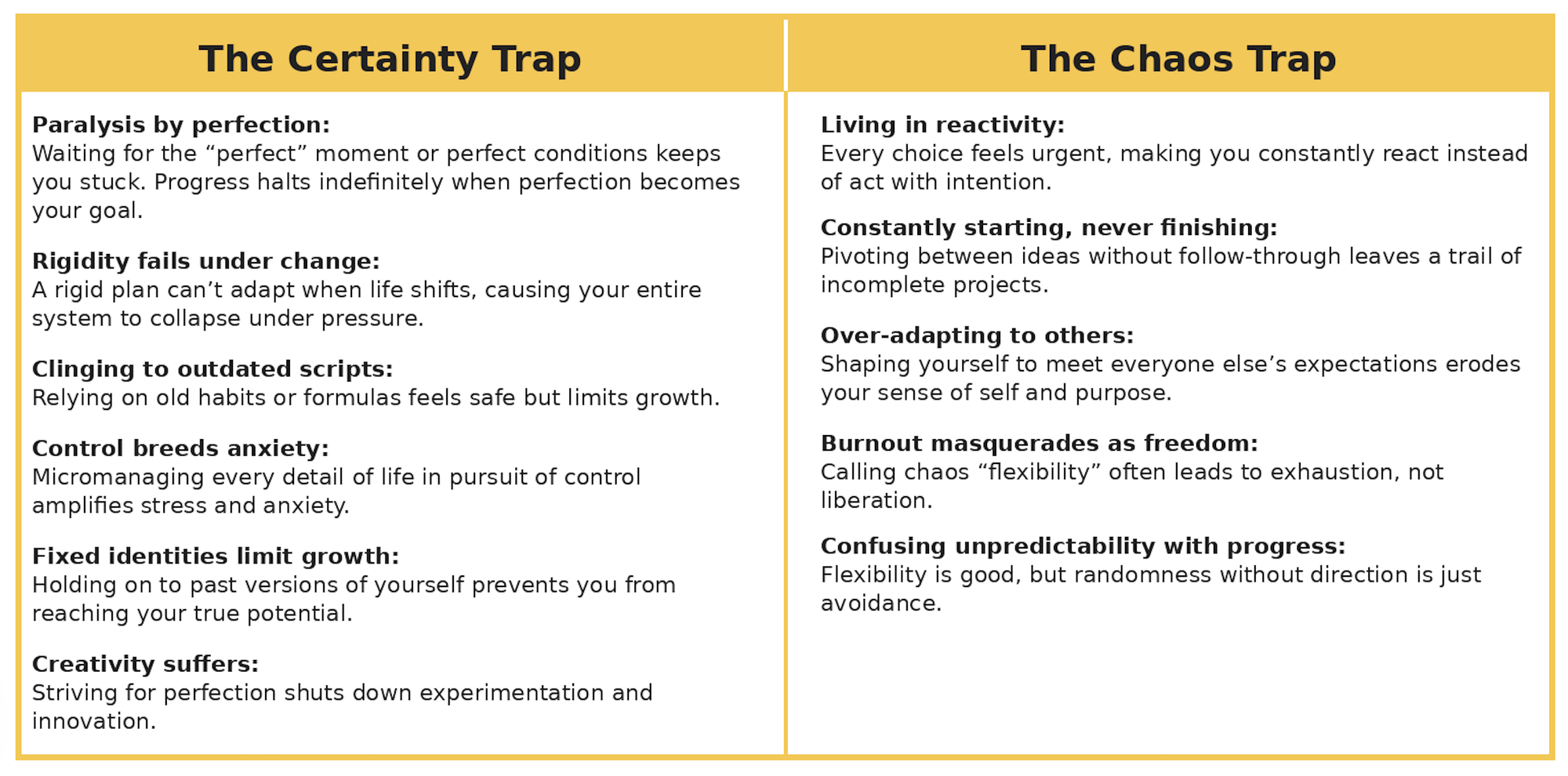P6: Uncertainty - Think Like a Beringian
"Uncertainty is the only certainty there is, and knowing how to live with insecurity is the only security." - John Allen Paulos
- The Problem: Most of us have been conditioned to treat uncertainty as a puzzle that must be solved. We wait for the “perfect plan,” the “right time,” or total clarity before taking action. But in today’s fast-changing world, clinging to certainty becomes a trap that leads to inaction.
- The Shift: What if, instead of chasing guarantees, we built the muscle to act without them? Think like an explorer navigating new terrain. Start taking small, deliberate steps. Use feedback to adjust your path. Adapt as you move forward. The secret is treating uncertainty as part of the game, not the thing to avoid.
- The Payoff: When you trade rigidity for flexibility, you replace analysis paralysis with progress. Instead of waiting for life to happen, you create momentum. Clarity isn’t something you have to wait for; it’s something you find in the act of moving. The result? Life becomes less about waiting for the “right moment” and more about discovering what’s possible through action.
Introduction – A Tale of Two Worlds
Long ago, a stretch of land connected two continents.
It was immense. Frozen. Harsh. And quietly slipping away.
Few people called this place home. Life there was anything but easy, but over time, they had adapted. They followed the movements of animals, hunted on the ice, and mastered the art of surviving the cold.
But the world was beginning to shift.
The ice under their feet was melting. Oceans were swelling. Seasons were altering. Slowly, almost imperceptibly, the land bridge they relied on was vanishing.
Faced with this reality, they stood before a choice.
To the west lay their ancestral lands. Familiar, dependable, and rooted in established traditions.
To the east stretched an uncharted expanse. No paths. No maps. Only the possibility of forging something new.
Some returned to their roots.
Some hesitated until the moment was lost.
But a bold few pressed forward into the unknown.
Unbeknownst to them, their leap of faith would lead to the establishment of entirely new civilizations. They endured, adapted, and ultimately prospered—not because they knew what lay ahead, but because they dared to take the first step.
The Blindspot That Holds Us Back
You’re not stuck. You’re simply choosing to wait.
Every time you hold off for “more certainty” or “the perfect timing,” you’re making a decision. It’s a decision that feels safe, but it quietly robs you of progress, opportunities, and confidence.
Here’s the truth: the world isn’t predictable. It’s messy and chaotic. Trying to make decisions with outdated mental models is like navigating a city with a 50-year old map.
Action doesn’t guarantee success, but inertia guarantees stagnation.
Here’s something worth remembering:
Around 20,000 years ago, during the last Ice Age, a land bridge called Beringia connected Siberia to Alaska, linking Asia and North America. It was a vast, habitable expanse where small groups of hunter-gatherers thrived.
Then, the world changed. Glaciers melted, seas rose, and Beringia began to vanish. The people living there had two options:
- Head back west to the well-known ecosystems of Asia.
- Venture east into the unknown, facing new terrain, climates, and a future full of uncertainty.
The choice they faced mirrors the choice we often face today. But instead of icy landscapes, our challenges are mental, economic, and cultural.
Now let's bring a modern-day parallel to these two worlds.
On one hand, there is the world of Certainia - similar to the old lands where the Ice Beringians might have returned to.
Certainia is a place where everything is mapped out, seasons follow a reliable rhythm, and the paths are already well-trodden. Here, milestones are set in stone, the rules don’t change, and careful planning consistently delivers results. It’s safe, predictable, and structured.
On the flip side, there’s the realm of Randomia - this might be the unknown lands those travelers might have faced had they ventered east.
Randomia is a chaotic, shifting landscape where the ground beneath your feet changes overnight. Landmarks disappear, new ones emerge, and no route comes with guarantees.
Randomia is messy, unpredictable, and full of unknowns. To succeed, you’ll need to stay flexible, experiment, and adjust as you go.
The Blindspot We Rarely Acknowledge
Most of us behave as though we live in “Certainia”—a predictable world where plans unfold perfectly and outcomes follow dependable rules. But we don’t. We live in “Randomia”—a complex, messy environment where nothing can be forecasted with certainty.
The problem is that we’re using Certainia’s rules in Randomia’s chaos. It’s like trying to follow a road map for a city that no longer exists. This mismatch quietly erodes our momentum, wastes our energy, and blinds us to opportunity.
The ones who adapt, who spot that they’ve crossed the border into Randomia, are the ones who thrive. They don’t wait for the perfect plan. They take action, test, learn, and iterate in the face of uncertainty.
Sometimes, the most important move isn’t knowing the perfect answer. It’s knowing when to act anyway.
Why This Matters Now
Every day, we face a choice: to stay where we are or move forward into the unknown.
You may not be standing on a melting land bridge, but you've likely experienced your version of "Beringia":
- The familiar is slipping away.
- The old rules no longer apply.
- Staying still feels risky, while taking a step forward feels uncertain.
Most people freeze in this moment, waiting for clarity, the perfect timing, or a sense of readiness. But here's the truth: in our fast-changing world, clarity seldom comes first. Waiting for it often means missing your chance.
Here’s where Beringian Thinking comes in:
- Take action without a perfect plan.
- Move forward without guaranteed outcomes.
- Trust yourself to figure things out through action.
Behind you lies "Certainia"—the world of fixed plans, control, and predictable comforts. Ahead lies "Randomia"—volatile, messy, but full of possibility. The question is simple but powerful: do you choose the comfort of certainty or the opportunity that uncertainty brings?
Why Holding onto Certainty No Longer Works
The old approach—that control and planning deliver security—is no longer reliable. Even with all the "right steps," today’s world doesn’t work the way you expect. Here’s what’s changed:
1. From Predictable to Complex Systems
- Then: The right data predicted outcomes.
- Now: Markets, ecosystems, and industries shift in real time. Outcomes emerge unpredictably.
2. Constant Change Is the New Normal
- Then: Stability alternated with phases of change.
- Now: Change is continuous, and stability is fleeting.
3. Rapid Skill Expiration
- Then: Careers and industries thrived for decades.
- Now: Entire industries can disappear in a few years. To stay relevant, skills require constant reinvention.
4. Information Overload
- Then: Limited inputs made decision-making more straightforward.
- Now: An avalanche of information leads to hesitation and second-guessing.
5. Life without Standardized Milestones
- Then: Shared milestones (school, career, retirement) shaped life’s decisions.
- Now: No single path defines success. Your roadmap must be unique.
6. Global Interconnectedness
- Then: Local plans were isolated from global events.
- Now: A disruption in one part of the world—from a supply chain issue to an AI breakthrough—can impact you immediately.
7. Expiring Plans
- Then: Five-year plans had longevity.
- Now: Even six-month plans become irrelevant in today’s speed-driven marketplaces.
The Core Lesson
You’re not failing. The system is outdated.
Trying to succeed in "Randomia" with the rules of "Certainia" is like sailing through a storm with a map meant for a hiking trail. You need a different strategy.
The modern world isn’t looking for perfect plans. Instead, it rewards adaptability, experimentation, and the ability to iterate. Success in this era belongs to those willing to take risks, adjust quickly, and view uncertainty as an advantage rather than a threat.
The New Survival Skill
Adaptability is no longer optional. It’s the skill that determines whether you survive and thrive in uncertain times.
Stop clinging to outdated playbooks. Build habits that encourage action, foster resilience, and help you adapt to whatever comes your way.
Use the uncertainty ahead as a proving ground to refine skills, uncover new opportunities, and grow stronger in the process. Today’s chaos isn’t the enemy—it’s the training ground for future success.
Why The Old Model Falls Short
For most of history, we’ve operated like life is a detailed map—with fixed landmarks, predictable paths, and a crystal-clear destination.
The unknown was treated like the distant wilderness, something you could avoid if you played your cards right.
But that view was always oversimplified. And today, it’s woefully outdated. Here’s why:
1. It Shrinks Reality Into a Comfort Zone
Life doesn’t fit into neat little boxes. When you assume most things can be predicted and controlled, you end up with a mental model that feels safe but ignores reality.
The real world is messy, constantly shifting, and full of randomness.
2. It Overestimates Stability, Underestimates Volatility
Our modern lives are shaped by complex, high-speed systems like global economies, technological waves, political upheavals, and social tipping points.
These systems are driven by feedback loops we can’t fully understand, much less control. Here’s the kicker: far more of your life is influenced by what’s unknown than what's known.
3. It Rewards Rigid Playbooks Over Flexible Thinking
Success used to mean mastering a pre-set rulebook. But those rules don’t last. The pace of change means you can’t rely on static expertise to get by. You need adaptive skills to keep up with new challenges and opportunities.
4. It Creates an Illusion of Control
When you think life is mostly predictable, unexpected events don’t just disrupt your plans—they break your worldview. You’re not just shocked by what happened; you’re paralyzed because you thought you were immune to surprise.
5. It Ignores the Power of Uncertainty
The unknown isn’t just where risks live; it’s where big opportunities reside too. If you treat uncertainty as a rare inconvenience, you’re more likely to be blindsided by its downsides and miss the upside entirely.
Here’s the shift we need to make:
Life isn’t a static map. Most of the terrain is uncharted, and thriving today means stepping into the unknown with curiosity and agility.
You’re not navigating through fixed landmarks anymore; you’re walking along dynamic, shifting landscapes. Success is about learning how to adapt and think clearly, even when the map can’t help you.
How We Got Here
Why do we crave certainty?
You wake up, glance at the clock, and begin your day with a plan.
You track your steps, tidy your inbox, and knock items off your to-do list.
Maybe you’ve got a roadmap for the future, a meticulously crafted five-year plan.
Even if you're running on empty, even if the world throws you curveballs faster than you can react, you cling tightly to tools, routines, and systems because they feel like anchors in an unpredictable world.
It’s not a flaw. It’s human.
It’s in our DNA.
The desire for certainty makes sense—we’ve been trained for thousands of years to equate control with safety, and predictability with survival.
That approach made sense in Certainia. But in Randomia, it's fatal.
Which is maybe why you’ve noticed something’s off.
The apps, the habits, the expert advice... they always promise to fix it, don’t they? Yet, the uncertainty never seems to disappear.
Why? The answer lies in how deeply we’ve mythologized certainty. To understand its hold on us, we need to trace its roots.
Life on the Edge: Where Uncertainty Was the Norm
For tens of thousands of years, humans lived on the move—as nomads, hunter-gatherers, and early explorers.
Every single day brought challenges like changing weather, migrating herds, unknown landscapes, and unexpected threats. Uncertainty wasn’t an obstacle.
It was the air we breathed. Humans read signs in nature, learned by trial and error, and improvised when plans fell apart. There was no “stepping into the unknown” because we never stepped out of it. Adapting to unpredictability was our default setting.
Farming Brings the First Glimpse of Stability
The Agricultural Revolution, roughly 10,000 years ago, changed everything.
Farming introduced a sense of predictability. Crops grew and were harvested in cycles. Surpluses could be stored. Stable settlements began to form. This was humanity’s first encounter with long-term planning.
But the order was fragile. A single drought, flood, or swarm of pests could undo months of labor.
To cope, humans turned to myths, rituals, and calendars—not to eradicate uncertainty, but to make it feel less overwhelming. These cultural tools made the unpredictable more manageable.
Civilization Institutionalized Certainty
Cities emerge. Laws are written. Systems of governance and religion step in to maintain order. Certainty isn’t just a clever survival strategy anymore—it’s immortalized as an ideal.
Rules and rituals guard against the unpredictable, framing chaos as dangerous. Order becomes moral. Certainty becomes a virtue.
The Enlightenment Pushed Rational Control
Fast forward again to the scientific revolution.
The idea of a fully measurable universe takes hold. Think about it. If we can study and quantify everything—from stars to human behavior—we can conquer the mystery of life. Certainty transforms from virtue into progress itself.
The Industrial Illusion of Control
The Industrial Revolution took humanity’s attempt at overcoming uncertainty several steps further.
Machines operated like clockwork. Railroads made travel reliable. Factories replaced seasonal labor with repetitive, predictable tasks. Life started to feel engineered for stability.
Cities grew to embody this mindset. Life became regimented with timetables, shift bells, and stricter roles. The unknown was treated as an occasional hiccup, something you could control with the right system or plan.
Certainty Becomes a Cultural Script in the 20th Century
Following World War II, this obsession with stability was baked into daily life.
A steady job, a suburban home with a mortgage, and a secure retirement became synonymous with success. Governments and large corporations acted as shock absorbers for life’s uncertainties, while insurance and financial planning promised safety.
Mass media painted life as a one-size-fits-all blueprint of education → career → family → retirement. Uncertainty became something to avoid at all costs.
Over time, our capacity to deal with unpredictability eroded. We outsourced risk management and forgot what it meant to rely on our own adaptability.
The Return of Uncertainty in the 21st Century
Fast forward to today, and that illusion of control is breaking down. Technology is outpacing regulation. Global markets and geopolitics change in an instant. Climate instability disrupts economies, populations, and coastlines. Pandemics close borders overnight.
We now live in a world where uncertainty is no longer a rare event. It has once again become the backdrop of daily life. But compared to our ancestors, who were conditioned to thrive in this kind of environment, we’ve largely lost the skills to adapt.
Why We Seek Out Certainty Today
| Biological Self | Cultural Self |
|---|---|
| Flexible, intuitive, adaptive | Scripted, structured, rigid |
| Comfortable in the unknown | Anxious without a plan |
| Emergent by nature | Linear by design |
Why It’s Time to Rethink Uncertainty
It’s no surprise we feel stuck.
For millennia, certainty was our lifeline. It gave us structure, safety, and a clear way forward.
But here's the harsh truth is:
The world of certainty was never as large or secure as we believed. For a brief moment in history, we pretended that the unknown was far away, out on the horizon.
That illusion worked for a while, but the window has closed.
The systems we designed to shield ourselves from uncertainty are now the same systems holding us back.
We’re biologically wired to adapt—but culturally, we’ve been taught to cling to what’s safe and familiar. That tension is what makes uncertainty feel so heavy.
To thrive now, we must rebuild our ability to operate in the unknown. We need to think, decide, and act with the mindset that uncertainty isn’t a rare inconvenience; it’s the terrain we live on.
Just like our ancestors, we need one foot planted in what we know, and the other ready to move forward into the fog. The ability to thrive in uncertainty isn’t just a survival skill anymore; it’s a competitive advantage.
Adaptability doesn’t mean tossing out structure altogether; it’s about learning to move with change instead of fighting against it.
The question is never if you’ll face uncertainty. The real question is how you’ll respond when it arrives.
(And that’s exactly what we’ll explore next.)
What Beringian Thinking Really Means
Navigating Two Worlds
Let's revisit the Beringia metaphor.
Beringians were Ice Age humans inhabiting the liminal space between what are now Siberia and Alaska.
For generations, they thrived in one of the most unpredictable environments on Earth. They didn’t follow rigid plans or overly scripted paths. They lived by instinct, navigated by what emerged around them, and adapted to a reality that was constantly shifting.
To “think like a Beringian” is to reconnect with the adaptive intelligence that humanity was built on.
It’s ancient wisdom, yet it fits perfectly into today’s volatile, unpredictable world.
It’s a way of moving forward—not by clinging to control, but by leaning into uncertainty with presence, curiosity, and courage.
A Modern Day Parallel
We've already met the two mental worlds. On one side is Certainia—a world of predictability, clear boundaries, and stable systems.
On the other is Randomia—a chaotic, messy, and unpredictable space.
You're already familiar with the terrain, so now let's take it a step further.
The Beringian Mindset: stability is useful, but adaptability is essential.
Two Lands, One Reality
Most of us don't exist solely in one world or the other.
Instead, we constantly move between the predictable landscape of Certainia and the unpredictable terrain of Ranomia.
But we spend far more time in Randomia than we acknowledge or accept.
The problem is that we cling to the mindset, rules, and playbook of Certainia even when deep inside the world of Randomia.
That's dangerous!
True success lies in moving fluidly between both worlds, using structure where it works and agility when it doesn’t.
The Beringian Mindset
Thinking like a Beringian means you don't cling to the rules of one world only. Instead, you:
- Move without maps — starting before perfect clarity
- Follow the emergent path — letting direction unfold from feedback
- Stay radically adaptive — bending faster than challenges can break them
- Bet small, learn fast — iterating instead of overcommitting
- Thrive in liminal space — seeing the in-between as fertile ground
Old World Thinking vs. Beringian Thinking
| Old World Thinking | Beringian Thinking |
|---|---|
| Wait for certainty | Move in uncertainty |
| Predict and plan | Prototype and test |
| Fixed identity and roles | Emergent identity |
| Linear path | Nonlinear navigation |
| Build fortresses | Build adaptability |
The Reality You Can't Ignore
We like to believe we live mostly in a world of certainty, with the occasional curveball throwing us into unpredictability.
The reality, however, is the opposite. Most of our lives are spent in Randomia, the land of unpredictability, and pretending otherwise is a recipe for frustration and failure.
Every day, you’re making decisions with incomplete information.
The client changes direction at the eleventh hour. Markets shift before your product even sees the light of day. A friend bails on plans you’d been counting on. A competitor you didn’t see coming disrupts your edge. Or perhaps it’s a chance encounter with someone who rewrites the story of your career or your life. One moment you’re fine, and the next, you’re grappling with life-altering test results.
Randomia isn’t a glitch in the system. It is the system.
Yet so many of us are set on carrying our playbook from the Land of Certainty into a world it doesn’t belong. We rely on rigid plans, fixed expectations, and the promise of predictable outcomes in a world that’s anything but.
This mismatch keeps us from pivoting quickly, leaves us fragile under pressure, and blinds us to opportunities we didn’t plan for.
You need to accept the fact there’s no waiting for things to “get back to normal.”
As we saw earlier, the stable, mostly certain world we long for wasn’t the default of human history. It was an anomaly.
The real advantage now is learning to flow between Certainty and Randomness. Randomia is where the game unfolds, where risks are highest—but so are the rewards.
If you can adapt your playbook to thrive in Randomia, you don’t just survive uncertainty, but you also harness it. That’s where flexibility beats fixation, where adaptability outpaces assurance, and where the real opportunities are waiting for those bold enough to step off the well-trodden path.
The Truth Nobody Talks About
We’ve been taught to approach life like a puzzle.
If we can just piece together the right combination of strategy, planning, and effort, everything suddenly makes sense. The fog will lift, the path will appear, and we'll finally have safety, success, and fulfillment.
But what if this mindset is the very thing holding you back?
Life isn’t a problem you solve. It’s a rhythm you learn to move with.
The answers you’re seeking? They’re not buried in your thinking.
They’re not waiting in some bulletproof strategy.
They surface through the experience itself, but only once you engage with it.
The Hidden Truth: Randomia is Home
Here’s an uncomfortable truth few people talk about: We’ve been treating certainty as if it’s the foundation of life, when in reality, uncertainty is the default.
We live as though "Certainia" (the fixed, predictable world of routines and plans) is our baseline.
We cling to steady jobs, career paths, and life plans to keep us anchored. But as we saw earlier, historically, this hasn’t been normal at all. For most of human history, the unpredictable world of “Randomia” was our reality. Survival depended on our ability to adapt, pivot, and make peace with the unknown.
The shift that needs to happen today is this:
- Uncertainty isn’t the exception. It’s the rule.
- What if, instead of resisting it, we learned to thrive in it?
This is the paradigm shift. Stop waiting for the calm after the storm and start building systems and instincts to engage confidently with uncertainty.
How to Flip the Script
For too long, we’ve been telling ourselves stories about how life is supposed to work:
- “Life follows a straight line”
- “Success comes from control”
- “Planning eliminates risk”
None of these ideas really hold up. The reality is:
- Clarity shows up after action, not before it.
- Life is dynamic, always changing.
- The path only becomes clear as you take steps forward.
Uncertainty isn’t a bug in the system. It is the system. Once you accept this, everything changes. The fear of the unknown starts to loosen its grip, and you can engage with life from a place of growth, not resistance.
8 Subtle Traps That Keep Us Chained to False Certainty
Even those who recognize life’s unpredictability can still fall victim to old habits and beliefs. Certainty hides in sneaky ways.
Here are eight common traps and how to break free from them.
1. The Linear Life Script
The old formula says life should look like this:
School → Career → Marriage → Mortgage → Retirement.
But life doesn’t always follow a preset script. Trying to force it into one just creates frustration.
Actionable Insight: Your safety doesn’t come from following someone else’s steps. It comes from writing your own script.
2. Over-Planning as Procrastination
Ever feel like building a perfect five-year plan makes you feel productive—but you still don’t take action? Plans can soothe, but life rarely sticks to them.
Actionable Insight: Start with small experiments. Test, learn, and adjust before committing to a grand plan.
3. Chasing the Perfect “Answer”
“What’s my true calling?” “What’s the best system?” Waiting for an answer can keep you stuck.
Actionable Insight: Purpose and clarity don’t come from thinking. They emerge when you engage fully with what’s in front of you.
4. Institutional Loyalty for Security
Hanging on to titles, jobs, or credentials for a false sense of stability—even when they’re no longer serving us.
Actionable Insight: Build your foundation by diversifying your skills and creating your own safety nets.
5. Fixed Identity Traps
“I’ve always been the [role]. That’s just who I am.”
Labels help us make sense of the world, but they can also box us in.
Actionable Insight: Treat your identity like a constantly evolving process. Update and adapt as needed.
6. The Myth of the “Right Time”
The lie we tell ourselves? Someday we’ll feel 100% ready. Conditions will be ideal. Spoiler alert: That day doesn’t exist.
Actionable Insight: Take imperfect action. Start small. Start now.
7. Over-Reliance on Data
Metrics can ease uncertainty, but they’re not decision-makers. They’re signposts.
Actionable Insight: Use data as one tool in your toolbox, but lean heavily on feedback from real actions and experiences.
8. How-To Overload
Learning so much that it keeps you stuck in consumption mode, instead of taking real action.
Actionable Insight: Curate what you consume. Apply what you learn immediately.
The Real Truth About Living with Uncertainty
We gravitate toward certainty because it feels familiar, not because it works. Over-planning, perfect timing, and procrastination aren’t shields against risk; they’re barriers to growth.
The way forward?
- Build resilience, not rigid plans.
- Focus on movement, not control.
- Trust the process of trial, error, and adaptation.
Agility isn’t just a buzzword for business. It’s the mindset you need for life. Once you start trusting the rhythm, you’ll stop fighting against the current and start thriving in the flow.
The question is, are you ready to step into action?
The Costs of Craving Certainty
Certainty feels safe. It’s marketed as the hallmark of maturity and success, offering the promise of stability in a chaotic world.
When life feels out of control, we look for routines, plans, and proven pathways—not because they’re the best option, but because they make us feel grounded.
The issue is when we try to build rock-solid plans while standing on shaky ground. The need for control and the illusion of stability harden into rigidity. That rigidity, once considered strength, quietly becomes the primary reason we feel stuck.
How Certainty Stops Your Growth
1. It Paralyzes Progress
Trying to wait for the “perfect time” is a trap. That ideal moment doesn’t exist. Meanwhile, ideas sit idle, opportunities pass, and momentum slows. Preparing endlessly ensures one thing: nothing gets done.
2. It Collapses Under Pressure
Rigid plans crack when life inevitably throws curveballs. Careers derail, identities waver, and self-worth suffers when external forces disrupt what felt like stability. When certainty is your foundation, unpredictability feels devastating.
3. It Keeps You Stuck in Outdated Roles
Certainty pushes you to follow traditional scripts, even when they no longer serve you. You stick to what’s “safe” instead of exploring paths that align with who you’re becoming. The longer you stay tethered to the past, the harder it is to move forward.
4. It Breeds Chronic Overthinking
The more you strive for control, the more anxious you become when life doesn’t follow your plan. Micromanaging everything only creates a cycle of stress and exhaustion. Deep down, you know the strategy is unsustainable, which adds to the burden.
5. It Limits Your Potential
Certainty locks you into fixed roles and identities. Evolving feels risky, and growth feels like abandoning what you know. This fear keeps you small, stuck, and playing a game far beneath your true potential.
6. It Crushes Creativity
Certainty demands perfection upfront. But creativity thrives on imperfection and experimentation. If there’s no room for trial and error, curiosity fades, and you end up avoiding the bold moves and messy exploration that lead to innovation.
The Other Extreme: When Chaos Becomes the Problem
Certainty isn’t without its flaws, but the opposite extreme, chaos, comes with its own set of costs. Some people, burnt out by rigidity, romanticize unpredictability.
They mistake constant pivots for progress and unstructured living for freedom when, in reality, unchecked chaos keeps them just as stuck.
Here are the signs you're lost in chaos:
- Reactive Living: Every choice feels like putting out a fire.
- Chronic Pivots: You start projects but rarely see them through.
- Excessive Adaptability: You bend to everyone else’s needs, neglecting your own.
- Burnout Explained Away: You call it “flexibility,” but you’re exhausted from constantly improvising.
While certainty hides in over-control, chaos hides in avoidance. Both make it impossible to move forward with purpose.
The Costs of Relying on Certainty vs. Chaos
Life is a balance between stability and adaptation. Relying too much on certainty leaves you rigid, while fully giving in to chaos creates disorder.
The solution? Mastering the art of pivoting between the two.
This dynamic approach is what we call "Agilism" and it's the rhythm that keeps you moving forward.

The Rythm of Agilism
The antidote to both traps is finding deliberate balance.
Avoid waiting for complete certainty, but don’t rush ahead without a plan either. Strive for grounded adaptability by starting small, testing ideas, and refining as you go.
Progress comes from intentional, consistent actions—not chasing perfection or descending into chaos.
Remember, Agilism is about recalibrating, adjusting your path, and redefining stability with purpose—not being overly strict, nor entirely untethered.
When you stop viewing chaos as freedom and structure as limitation, you create the space necessary for true growth.
Stay anchored in the present, maintain flexibility for shifting conditions, and design systems that promote both stability and adaptability, so every change leaves you stronger.
What This Principle Is NOT
Before we go any further, let's straighten out a common misunderstanding.
When we talk about “dancing with life” or approaching uncertainty with agility, some people assume it means giving into chaos, passively going with the flow, or moving aimlessly without direction.
But that’s not what Agilism is about.
Agilism doesn’t mean avoiding commitment, ignoring structure, or reacting impulsively to whatever comes your way. True Agilism is a deliberate practice. It’s about navigating the unknown with clear intent, focus, and purpose.
Understanding what Agilism is not gives you the clarity to incorporate it into your life in a way that is effective and meaningful.
❌ It's NOT about losing direction – 'Thinking Like a Beringian' isn’t some passive "go with the flow" cliché.
Agilism isn’t about abandoning your values, goals, or focus.
You still choose your direction, stay anchored to what matters, and take decisive steps forward.
Think of it this way: you lead the dance—but you stay tuned to the rhythm as it evolves.
❌ It's NOT anti-planning – Planning is still valuable, but rigid, overly prescriptive plans? Those belong in the past.
Agilism says, "Plan like a prototype, not like a prophecy.”
Forget your airtight 10-year plan; instead, think in 10-day experiments.
Build flexible scaffolding that supports movement, not concrete walls that trap you.
❌ It's NOT chaos worship – Uncertainty isn’t the goal here; it’s the given reality.
This principle doesn’t glorify unpredictability or encourage reactive decision-making.
Instead, it’s about upgrading your systems to handle change—not dismantling them altogether.
Chaos is noise. Agilism teaches you to find the melody.
❌ It's NOT escapism – Agilism doesn’t mean avoiding responsibility or dodging tough calls.
True agilism means facing challenges head-on but with curiosity, iteration, and presence.
This isn’t about skipping the hard work. It’s about doing it smarter.
Remember, you’re not bypassing the work. This is the work.
❌ It's NOT mystical fluff – This isn’t some woo-woo, spiritual buzzword.
Agilism is rooted in how complex systems naturally evolve.
Nature, economies, organisms all thrive through emergence, feedback loops, and iterative adaptation—not rigid controls.
Think systems thinking over mysticism. Meta-logical, not magical.
❌ It's NOT indecision disguised as depth – Agilism doesn’t mean hesitating endlessly. You still make moves.
The difference is you don’t stall, waiting for perfect knowledge before acting.
Instead, you decide to go forward, learn along the way, and adjust with intention.
Agility is active participation—not passive observation.
The bottom line:
Agilism isn’t about giving up, opting out, or aimlessly floating.
It’s about trading rigidity for disciplined adaptability.
It’s about moving fluently through life—not stalling in chaos or control.
And most importantly, it’s about accepting uncertainty while staying fully engaged with what matters most.
The Real Mindset Shift
Our ancient Beringian ancestors didn’t thrive during the Ice Age by waiting for perfect conditions or meticulously over-planning.
Instead, they mastered adaptability, staying nimble between solid land and shifting ice. They moved with the moment, adjusted their path, and read their environment like a living map.
This embodies the essence of Agilism—acting with clarity but avoiding the trap of perfectionism.
| Old Mindset | New Mindset |
|---|---|
| Sees life as a problem to solve | Sees life as a pattern to co-create |
| Success = control | Success = adaptability |
| More planning = more security | More trial and error = clearer insight |
| Figure it all out first | Move first, clarity will follow |
| Certainty is the goal | Capacity for uncertainty is the superpower |
The Anxiety of Uncertainty
Uncertainty isn’t a disruption. It’s the environment.
Much of the stress we associate with uncertainty doesn’t come from the uncertainty itself but from the belief that it shouldn’t exist—that we should always have control. This mindset sets us up for frustration and stagnation.
Agilism flips this belief on its head. Instead of resisting the unpredictable, it teaches us to move with it.
By becoming more flexible, we can transform uncertainty into an opportunity to grow and adapt.
Here's what Thinking Like a Beringian really stands for:
✅ It's a Mindset Shift: Stop treating life like a fixed puzzle. Instead, approach it like a landscape that’s constantly changing. The goal isn’t to find “the answer,” but to discover the next step forward. Focus on adaptability, not control.
✅ It's Action Over Perfection: Don’t wait until you know everything to start. Clarity often comes from action. Like early explorers in unpredictable terrains, you learn by doing. Waiting for certainty will only hold you back.
✅ It's Awareness and Adjustment: Think of life as constantly shifting ice. Notice changes early, make small moves, and adapt quickly rather than being forced to react under pressure.
✅ It's Engagement, Not Retreat: Hard moments aren’t barriers to avoid; they’re edges to lean into. Success lies in confronting challenges outright and responding to them in real-time.
✅ It's Navigating Complexity Like a Pro: A map will never be final, especially in a world growing more complex. Instead, look for patterns, make small bets, and adjust your approach as you learn.
✅ It's a Return to Our Roots: From our ancestors hunting in harsh terrains to modern professionals navigating rapid change, humans thrive when we stay adaptive, iterative, and connected to the moment.
In summary, Agilism isn’t about erasing fear or forcing stability. It’s about stepping into life’s unknown with confidence in your ability to adapt and thrive. Movement always matters more than mastery; flexibility beats rigidity.
You don’t need perfect circumstances, and you don’t always need a detailed plan. Start with what you know, take small steps, and adjust along the way. That’s how you not only survive but also flourish in a complex world.
What to Remember
- Responsiveness over rigidity. Stop focusing on total control.
- Action beats hesitation. Waiting won’t bring solutions. Movement will.
- Engagement over detachment. Build momentum by leaning into challenges.
Agilism is your strategy for navigating the changing terrain of life. It’s about staying curious, flexible, and ready to make the next best move—even when the horizon isn’t clear.
Final Thoughts
We’re not living in a time of certainty.
We're living in an age of constant emergence. Systems are unraveling, the ground continues to shift, and the future stubbonly refuses to follow a predictable script.
The old strategy of “figure it out, lock it in, and follow the plan” is falling apart. It isn't failing because you're failing. It's failing because it wasn't designed for this dynamic, fast-changing world.
Agilism is about viewing life not as a problem to solve but as a pattern to engage with. It’s the skill of sensing, adapting, and creating while staying in motion, even when the path ahead is unclear. Instead of chasing the illusion of control, it’s about developing a genuine relationship with reality.
Life is not a problem to solve; it’s a pattern to engage with
Rigid plans can leave you stuck while the world moves on. You don’t need to micromanage life. You need to work with it. You don’t need every single answer before you start. You need better questions and a willingness to take action while those questions still unfold.
Agilism is curiosity in action. It’s the capacity to thrive in uncertainty—not by resisting unpredictability as the enemy, but by treating it as the environment you adapt to.
This shift positions you to reclaim control—not through certainty, but by building the flexibility to move forward even when the road is messy.
If you’re looking for the way ahead, it’s here: stay curious, stay adaptive, and keep asking better questions.
That’s how you create success in a world where the only constant is change.
Additional Resources:
FAQs About the Beringian Mindset
▶ Why haven't I heard about this before?
A: Because most systems profit from your reliance on their plans or products.
The Beringian Mindset doesn’t sell control. It reclaims your agency. It’s not a “life hack” designed to fix you; it’s about unlocking your ability to adapt and thrive.
▶ What happens when I adopt the Beringian Mindset?
A: Everything changes. Anxiety turns to curiosity. Failure feels less loaded. Decisions get lighter.
You stop waiting for guarantees. You start moving. And as you move, clarity follows. Life unfolds, not because it becomes predictable, but because you stop needing it to be.
▶ What am I trading for the comfort of certainty?
A: When you cling to control, you're unintentionally sidelining discovery. Every hour spent maintaining the illusion of control is an hour stolen from exploring new possibilities. Ask yourself which unlived paths you're paying for in exchange for staying comfortable.
▶ Is this instability real, or just fear in disguise?
A: You must distinguish between signal and noise. True instability shows up through tangible feedback, like market shifts, data trends, or even physical signs.
Fear, on the other hand, is often just a projection from your mind's future simulator. If nothing external has actually changed, you're wrestling with a ghost.
▶ Is it okay to want certainty?
A: Of course. The desire for certainty is deeply human. The danger is in depending on it.
Making certainty a prerequisite for action shuts down growth. True resilience doesn’t rely on guarantees; it comes from your ability to respond when uncertainty arises.
▶ What invisible scripts from Certainia are influencing my decisions today?
A: Seek out the untested rules guiding your life, such as “education-career-mortgage-retirement,” “or find your passion,” or “retire by 65.”
Who wrote these rules? If you're not able to identify a specific author or origin, then it's likely it's outdated cultural hand-me-down code still operating in the background.
▶ What cherished belief would crumble if I truly embraced Randomia?
A: Often, it’s blind faith in meritocracy - that if you work hard and play by the rules, you're guaranteed a certain outcome. Or it could be reliance on rigid forecasts, or the idea that your identity is static.
When you make the break from these narratives, the ground can disappear between your feet. But recognize that on the other side lies freedom. This is the point where you stop chasing control and start designing systems for adaptability.
▶ If life is no longer linear or predictable, how do you define progress?
A: Forget the straight paths and five-year plans. Measure progress through validated learning and feedback loops. It’s not about how straight your roadmap is, but how frequently you adapt and grow.
▶ If life is an experiment, what hypothesis should I be testing right now?
A: One hypothesis could be, “If I stay on this path, then stability will follow!" Or, "If I pivot now, I will look like a failure." Or, "If I work really hard at this, then xyz will be the outcome."
Make your hidden hypothesis explicit, then design a small experiment to test it. Brute force reality gives you a much better answer than overthinking or overplanning.
▶ What if I optimized my calendar for adaptability rather than efficiency, how would that look?
A: You'd see less time for 'busyness." You'd have "slack time" blocked out for reflection, exploring adjacent skills, and responding to opportunities.
▶ How can I become stronger when uncertainty spikes?
A: Seek out friendships and connections with people who don't look for solutions instead of catastrophizing.
Develop habits that renew (sleeping, reading, excercise).
Focus on personal assets that appreciate (cash buffers, skills).
But don't wait until the storms hit. Build those things now.
▶ If opportunity knocked tomorrow, should I wait?
A: Your “yes-speed” reflects your adaptive capacity. Things like having high debt, rigid routines, or clinging to an old identity can slow you down. Streamline now and build in optionality, so that when the moment arrives, you can seize it, not just contemplate it.
Toolkit
This section is currently in development.
We're currently gathering thoughtful questions to provide clear and helpful answers that expand on the ideas shared above.
We aim to aim to launch this section shortly.
Please check back soon!
Next Steps:
- ← Back to All 21 Principles
Browse the full library of Agilism’s foundational ideas for navigating a nonlinear world. - Explore the Dimensions →Lifestyle Design, Emotional Flexibility, Mental Models, Atomic Goal Setting (Coming soon: clickable cards for each gateway).
- Return to the Full Agilism Overview →
A primer on what it is, where it came from, and why it matters. - Download the “21 Principles” eBook →
Subscribe to our newsletter to get your copy and stay updated with fresh insights as the framework evolves.
Next Steps:
- ← Back to All 21 Principles
Browse the full library of Agilism’s foundational ideas for navigating a nonlinear world. - Explore the Dimensions →Lifestyle Design, Emotional Flexibility, Mental Models, Atomic Goal Setting (Coming soon: clickable cards for each gateway).
- Return to the Full Agilism Overview →
A primer on what it is, where it came from, and why it matters. - Download the “21 Principles” eBook →
Subscribe to our newsletter to get your copy and stay updated with fresh insights as the framework evolves.

Previous

Next
Explore the Other Agilism Dimensions
Browse other Dimensions to expand your Agilism journey






